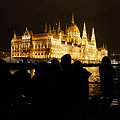
 Turist- og rejseinformation
Turist- og rejseinformation
(Optimeret til enheder med små skærme)
Downtown, riverbank of Tisza - Szolnok, Ungarn
Når du klikker:
Klik på billederne!
-
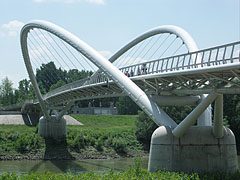
Tiszavirág Bridge, a footbridge in Szolnok, crossing point over the Tisza River for pedestrians and cyclists
Interestingly the Celtic Gateway Bridge in Holyhead, Wales, Great Britain is quite similar to this, that was built in 2006.
Dato for fotografering: 07-06-20142014
Skabt af: Robert Németh
Kameramodel: Konica Minolta Dimage A200
Szolnok, Ungarn
-
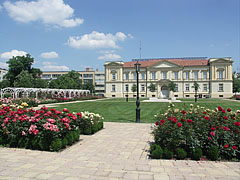
The baroque style Verseghy Park
The idea of the park comes from 1855, but was realized only in the 1930s by the plans of Béla Rerrich.
Dato for fotografering: 07-06-20142014
Skabt af: Robert Németh
Kameramodel: Konica Minolta Dimage A200
Szolnok, Ungarn
-
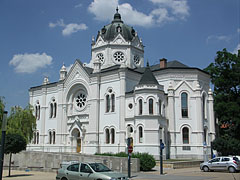
Szolnok Gallery in the magnificent moorish style former synagogue
Designed by Lipót Baumhorn, built in 1898
Dato for fotografering: 07-06-20142014
Skabt af: Robert Németh
Kameramodel: Konica Minolta Dimage A200
Szolnok, Ungarn
-
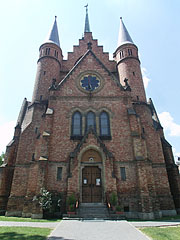
The castle-like brick-walled neo-gothic style Reformed church of Szolnok
Built between 1893-1894, architect: Ottó Sztehlo
Dato for fotografering: 07-06-20142014
Skabt af: Robert Németh
Kameramodel: Konica Minolta Dimage A200
Szolnok, Ungarn
-

"Mating dance of the mayflies" or "Tisza mayfly couple" sculpture and fountain in the park
Created by Gábor Varga in 2011
Dato for fotografering: 07-06-20142014
Skabt af: Robert Németh
Kameramodel: Konica Minolta Dimage A200
Szolnok, Ungarn
-
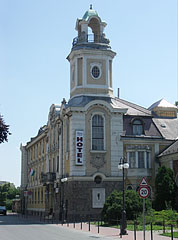
The Hotel Tisza is one of the oldest hotels in Szolnok
Dato for fotografering: 07-06-20142014
Skabt af: Robert Németh
Kameramodel: Konica Minolta Dimage A200
Szolnok, Ungarn
-
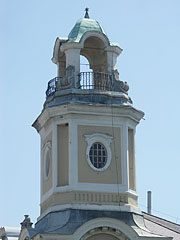
The tower of the Hotel Tisza
Dato for fotografering: 07-06-20142014
Skabt af: Robert Németh
Kameramodel: Konica Minolta Dimage A200
Szolnok, Ungarn
-
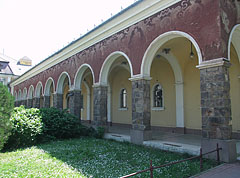
The sgraffito decorated archway of the Tisza Hotel, Spa and Thermal Bath
Dato for fotografering: 07-06-20142014
Skabt af: Robert Németh
Kameramodel: Konica Minolta Dimage A200
Szolnok, Ungarn
-
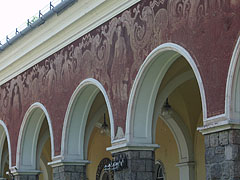
The arcades of the medicinal and thermal bath
Dato for fotografering: 07-06-20142014
Skabt af: Robert Németh
Kameramodel: Konica Minolta Dimage A200
Szolnok, Ungarn
-
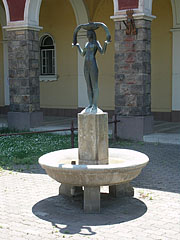
"Girl with fish" statue in an ornamental fountain in front of the thermal bath archway
The sculpture was created by Zoltán Borbereki Kovács in 1937. There is a copy of it in the park of the Tiszaliget Beach, that one was inaugurated in 1964.
Dato for fotografering: 07-06-20142014
Skabt af: Robert Németh
Kameramodel: Konica Minolta Dimage A200
Szolnok, Ungarn
-
Detail of the Thermal Bath building
The 55.6 celsius degree alkaline hydrogen carbonate and iodine thermal water of the bath comes up from a depth of 950 meters. It was discovered by Ferenc Pávai Vajna geologist (1886-1964) in 1928.
Dato for fotografering: 07-06-20142014
Skabt af: Robert Németh
Kameramodel: Konica Minolta Dimage A200
Szolnok, Ungarn
Detail of the Thermal Bath building - Szolnok, Ungarn -
Claret colored sgraffito (scraped plaster technique) wall decoration on the arcades of the Medicinal and Thermal Bath
Dato for fotografering: 07-06-20142014
Skabt af: Robert Németh
Kameramodel: Konica Minolta Dimage A200
Szolnok, Ungarn
Claret colored sgraffito (scraped plaster technique) wall decoration on the arcades of the Medicinal and Thermal Bath - Szolnok, Ungarn -
A male figure defeats a dragon, memorial plaque of the victims in the communist proletarian dictatorship in 1919, on the wall of Hotel Tisza
Created by Gábor Benő Pogány in 2004, probably inspired by the dragon slayer sculpture of Richárd Füredi from 1934.
Dato for fotografering: 07-06-20142014
Skabt af: Robert Németh
Kameramodel: Konica Minolta Dimage A200
Szolnok, Ungarn
A male figure defeats a dragon, memorial plaque of the victims in the communist proletarian dictatorship in 1919, on the wall of Hotel Tisza - Szolnok, Ungarn -
The turreted neo-baroque building of the Tisza Hotel
Dato for fotografering: 07-06-20142014
Skabt af: Robert Németh
Kameramodel: Konica Minolta Dimage A200
Szolnok, Ungarn
The turreted neo-baroque building of the Tisza Hotel - Szolnok, Ungarn -
Nice closed balcony on the wall of Hotel Tisza
Dato for fotografering: 07-06-20142014
Skabt af: Robert Németh
Kameramodel: Konica Minolta Dimage A200
Szolnok, Ungarn
Nice closed balcony on the wall of Hotel Tisza - Szolnok, Ungarn -
The neo-baroque Tisza Hotel and Medicinal Thermal Bath
Built in 1928, architect: Ármin Hegedűs
Dato for fotografering: 07-06-20142014
Skabt af: Robert Németh
Kameramodel: Konica Minolta Dimage A200
Szolnok, Ungarn
The neo-baroque Tisza Hotel and Medicinal Thermal Bath - Szolnok, Ungarn -
The entrance of the 3-star Hotel Tisza (Tisza Hotel and Thermal Bath)
Dato for fotografering: 07-06-20142014
Skabt af: Robert Németh
Kameramodel: Konica Minolta Dimage A200
Szolnok, Ungarn
The entrance of the 3-star Hotel Tisza (Tisza Hotel and Thermal Bath) - Szolnok, Ungarn -
The tower of the Tisza Hotel and Thermal Bath
Dato for fotografering: 07-06-20142014
Skabt af: Robert Németh
Kameramodel: Konica Minolta Dimage A200
Szolnok, Ungarn
The tower of the Tisza Hotel and Thermal Bath - Szolnok, Ungarn -
The neo-baroque style Tisza Hotel, Medicinal and Thermal Bath
Built in 1928, architect: Ármin Hegedűs
Dato for fotografering: 07-06-20142014
Skabt af: Robert Németh
Kameramodel: Konica Minolta Dimage A200
Szolnok, Ungarn
The neo-baroque style Tisza Hotel, Medicinal and Thermal Bath - Szolnok, Ungarn -
Walkway in the Verseghy Park
Dato for fotografering: 07-06-20142014
Skabt af: Robert Németh
Kameramodel: Konica Minolta Dimage A200
Szolnok, Ungarn
Walkway in the Verseghy Park - Szolnok, Ungarn -
Fountain with stone frogs in the Verseghy Park
Dato for fotografering: 07-06-20142014
Skabt af: Robert Németh
Kameramodel: Konica Minolta Dimage A200
Szolnok, Ungarn
Fountain with stone frogs in the Verseghy Park - Szolnok, Ungarn -
Wedding photography between the roses in the Verseghy Park
Dato for fotografering: 07-06-20142014
Skabt af: Robert Németh
Kameramodel: Konica Minolta Dimage A200
Szolnok, Ungarn
Wedding photography between the roses in the Verseghy Park - Szolnok, Ungarn -
Wedding photography at the County Hall in the park full of roses
Dato for fotografering: 07-06-20142014
Skabt af: Robert Németh
Kameramodel: Konica Minolta Dimage A200
Szolnok, Ungarn
Wedding photography at the County Hall in the park full of roses - Szolnok, Ungarn -
Water spouting stone frog sculptures on the fountain in the Verseghy Park
Dato for fotografering: 07-06-20142014
Skabt af: Robert Németh
Kameramodel: Konica Minolta Dimage A200
Szolnok, Ungarn
Water spouting stone frog sculptures on the fountain in the Verseghy Park - Szolnok, Ungarn -
Spacious grassy field in the Verseghy Park, close to the riverbank
The big flood of the Tisza River in 2000 caused serious damage in the park, then it was restored by the plans of Dr. Imre Jámbor.
Dato for fotografering: 07-06-20142014
Skabt af: Robert Németh
Kameramodel: Konica Minolta Dimage A200
Szolnok, Ungarn
Spacious grassy field in the Verseghy Park, close to the riverbank - Szolnok, Ungarn -
Bust sculpture of Ferenc Verseghy Hungarian poet and linguist (1757-1822) in the riverside park named after him
Created by Zoltán Borbereki Kovács in 1934
Dato for fotografering: 07-06-20142014
Skabt af: Robert Németh
Kameramodel: Konica Minolta Dimage A200
Szolnok, Ungarn
Bust sculpture of Ferenc Verseghy Hungarian poet and linguist (1757-1822) in the riverside park named after him - Szolnok, Ungarn -
The Verseghy Park with a small ornamental pool, some distance away it is the steeple of the Roman Catholic Castle Church of Szolnok
Dato for fotografering: 07-06-20142014
Skabt af: Robert Németh
Kameramodel: Konica Minolta Dimage A200
Szolnok, Ungarn
The Verseghy Park with a small ornamental pool, some distance away it is the steeple of the Roman Catholic Castle Church of Szolnok - Szolnok, Ungarn -
Ornamental pool with a fountain in the grassy area of the Verseghy Park
Dato for fotografering: 07-06-20142014
Skabt af: Robert Németh
Kameramodel: Konica Minolta Dimage A200
Szolnok, Ungarn
Ornamental pool with a fountain in the grassy area of the Verseghy Park - Szolnok, Ungarn -
Verseghy Park
Dato for fotografering: 07-06-20142014
Skabt af: Robert Németh
Kameramodel: Konica Minolta Dimage A200
Szolnok, Ungarn
Verseghy Park - Szolnok, Ungarn -
The riverside facade of the County Hall, viewed from the Verseghy Park
The two-storey eclectic building was built in 1878 by the plans of Károly Benkó, but this southern facade is designed by Lajos Zombory architect-painter in 1926.
Dato for fotografering: 07-06-20142014
Skabt af: Robert Németh
Kameramodel: Konica Minolta Dimage A200
Szolnok, Ungarn
The riverside facade of the County Hall, viewed from the Verseghy Park - Szolnok, Ungarn -
Pavilion with rose bushes around it in the Verseghy Park
Dato for fotografering: 07-06-20142014
Skabt af: Robert Németh
Kameramodel: Konica Minolta Dimage A200
Szolnok, Ungarn
Pavilion with rose bushes around it in the Verseghy Park - Szolnok, Ungarn -
Spacious wooden pergola in the roses, more precisely it is a bandstand, music pavilion
Dato for fotografering: 07-06-20142014
Skabt af: Robert Németh
Kameramodel: Konica Minolta Dimage A200
Szolnok, Ungarn
Spacious wooden pergola in the roses, more precisely it is a bandstand, music pavilion - Szolnok, Ungarn -
Rose arbour in the Verseghy Park
Dato for fotografering: 07-06-20142014
Skabt af: Robert Németh
Kameramodel: Konica Minolta Dimage A200
Szolnok, Ungarn
Rose arbour in the Verseghy Park - Szolnok, Ungarn -
Rosarium (rose arbor) in the Verseghy Park
Dato for fotografering: 07-06-20142014
Skabt af: Robert Németh
Kameramodel: Konica Minolta Dimage A200
Szolnok, Ungarn
Rosarium (rose arbor) in the Verseghy Park - Szolnok, Ungarn -
Arbor of the Hungarian bred roses in the Verseghy Park
Dato for fotografering: 07-06-20142014
Skabt af: Robert Németh
Kameramodel: Konica Minolta Dimage A200
Szolnok, Ungarn
Arbor of the Hungarian bred roses in the Verseghy Park - Szolnok, Ungarn -
Garden of the Hungarian Roses, rosarium in the Verseghy Park
There are only Hungarian bred, decorative, drought-tolerant and disease resistant rose species in this garden.
Dato for fotografering: 07-06-20142014
Skabt af: Robert Németh
Kameramodel: Konica Minolta Dimage A200
Szolnok, Ungarn
Garden of the Hungarian Roses, rosarium in the Verseghy Park - Szolnok, Ungarn -
The „Water drop park” or „Béres Fountain” white limestone-granite stone sculpture and drinking well
It was created in memory of Dr. József Béres sr., inventor of the Béres Drops ("Béres Csepp"). The medicinal water of the fountain is coming from the thermal well of the Tisza Hotel. Created by Gábor Miklya Gábor in 2012.
Dato for fotografering: 07-06-20142014
Skabt af: Robert Németh
Kameramodel: Konica Minolta Dimage A200
Szolnok, Ungarn
The „Water drop park” or „Béres Fountain” white limestone-granite stone sculpture and drinking well - Szolnok, Ungarn -
Rose arbor in the Verseghy Park, and the tower of the Lutheran church in the background
Dato for fotografering: 07-06-20142014
Skabt af: Robert Németh
Kameramodel: Konica Minolta Dimage A200
Szolnok, Ungarn
Rose arbor in the Verseghy Park, and the tower of the Lutheran church in the background - Szolnok, Ungarn -
Wonderful baroque style geometric garden with roses and the County House building
Instead of this nice park the Damjanich Swimming Pool was here between 1949 and 2009.
Dato for fotografering: 07-06-20142014
Skabt af: Robert Németh
Kameramodel: Konica Minolta Dimage A200
Szolnok, Ungarn
Wonderful baroque style geometric garden with roses and the County House building - Szolnok, Ungarn -
The Verseghy Park with the Garden of the Hungarian Roses (Rosarium)
Dato for fotografering: 07-06-20142014
Skabt af: Robert Németh
Kameramodel: Konica Minolta Dimage A200
Szolnok, Ungarn
The Verseghy Park with the Garden of the Hungarian Roses (Rosarium) - Szolnok, Ungarn -
The statue of Count Gyula Szapáry former Hungarian prime minister (1832-1905) and the County Hall in the Verseghy Park
Dato for fotografering: 07-06-20142014
Skabt af: Robert Németh
Kameramodel: Konica Minolta Dimage A200
Szolnok, Ungarn
The statue of Count Gyula Szapáry former Hungarian prime minister (1832-1905) and the County Hall in the Verseghy Park - Szolnok, Ungarn -
Statue of Count Gyula Szapáry in the renewed park
Created by Gábor Benő Pogány in 2013, based on the figurine of Ferenc Simon from 2009 and the original statue of Zoltán Borbereki Kovács from 1939.
Dato for fotografering: 07-06-20142014
Skabt af: Robert Németh
Kameramodel: Konica Minolta Dimage A200
Szolnok, Ungarn
Statue of Count Gyula Szapáry in the renewed park - Szolnok, Ungarn -
Verseghy Park
Dato for fotografering: 07-06-20142014
Skabt af: Robert Németh
Kameramodel: Konica Minolta Dimage A200
Szolnok, Ungarn
Verseghy Park - Szolnok, Ungarn -
Stone vase in the Verseghy Park
Dato for fotografering: 07-06-20142014
Skabt af: Robert Németh
Kameramodel: Konica Minolta Dimage A200
Szolnok, Ungarn
Stone vase in the Verseghy Park - Szolnok, Ungarn -
An Antonov An-2 airplane (registration mark: HA-ANV) is flying over the Tisza River, on the occasion of the Szolnok Airshow
This soviet aircraft type was manufactured between 1947 and 2004, its nickname in Hungary is "Ancsa".
Dato for fotografering: 07-06-20142014
Skabt af: Robert Németh
Kameramodel: Konica Minolta Dimage A200
Szolnok, Ungarn
An Antonov An-2 airplane (registration mark: HA-ANV) is flying over the Tisza River, on the occasion of the Szolnok Airshow - Szolnok, Ungarn -
The HA-ANV Antonov An-2 aircraft
This certain plane was manufactured in the PZL-Mielec factory in Poland, not in the Soviet Union.
Dato for fotografering: 07-06-20142014
Skabt af: Robert Németh
Kameramodel: Konica Minolta Dimage A200
Szolnok, Ungarn
The HA-ANV Antonov An-2 aircraft - Szolnok, Ungarn -
Wall lamp at the entrance of Hotel Tisza
Dato for fotografering: 07-06-20142014
Skabt af: Robert Németh
Kameramodel: Konica Minolta Dimage A200
Szolnok, Ungarn
Wall lamp at the entrance of Hotel Tisza - Szolnok, Ungarn -
The entrance of Tisza Hotel and Medicinal Thermal Bath
Dato for fotografering: 07-06-20142014
Skabt af: Robert Németh
Kameramodel: Konica Minolta Dimage A200
Szolnok, Ungarn
The entrance of Tisza Hotel and Medicinal Thermal Bath - Szolnok, Ungarn -
The columned archway of the Tisza Hotel and Spa
Dato for fotografering: 07-06-20142014
Skabt af: Robert Németh
Kameramodel: Konica Minolta Dimage A200
Szolnok, Ungarn
The columned archway of the Tisza Hotel and Spa - Szolnok, Ungarn -
"Tisza Hotel and Spa" sgraffito technique caption on the arcades of the hotel and thermal bath building complex
Dato for fotografering: 07-06-20142014
Skabt af: Robert Németh
Kameramodel: Konica Minolta Dimage A200
Szolnok, Ungarn
"Tisza Hotel and Spa" sgraffito technique caption on the arcades of the hotel and thermal bath building complex - Szolnok, Ungarn -
The spa of the Hotel Tisza
However this building seems a little bit run-down from outside, it is nothing compared to its condition in the World War II, when it was a Soviet military hospital and then completely plundered by the Soviet Red Army.
Dato for fotografering: 07-06-20142014
Skabt af: Robert Németh
Kameramodel: Konica Minolta Dimage A200
Szolnok, Ungarn
The spa of the Hotel Tisza - Szolnok, Ungarn -
Tisza Hotel, the from outside a little bit characterless circular dome hall of the thermal bath (but the interior of the Turkish-style spa is much better)
Dato for fotografering: 07-06-20142014
Skabt af: Robert Németh
Kameramodel: Konica Minolta Dimage A200
Szolnok, Ungarn
Tisza Hotel, the from outside a little bit characterless circular dome hall of the thermal bath (but the interior of the Turkish-style spa is much better) - Szolnok, Ungarn -
This part of the Tisza Park is still a bit neglected, waiting for renovation
Dato for fotografering: 07-06-20142014
Skabt af: Robert Németh
Kameramodel: Konica Minolta Dimage A200
Szolnok, Ungarn
This part of the Tisza Park is still a bit neglected, waiting for renovation - Szolnok, Ungarn -
Statue of Zounok, the first steward Szolnok, a bronze male fugure stands on a granite boat
Created by Gábor Benő Pogány in 2001
Dato for fotografering: 07-06-20142014
Skabt af: Robert Németh
Kameramodel: Konica Minolta Dimage A200
Szolnok, Ungarn
Statue of Zounok, the first steward Szolnok, a bronze male fugure stands on a granite boat - Szolnok, Ungarn -
Bronze statue of steward Zounok
Created by Gábor Benő Pogány in 2001
Dato for fotografering: 07-06-20142014
Skabt af: Robert Németh
Kameramodel: Konica Minolta Dimage A200
Szolnok, Ungarn
Bronze statue of steward Zounok - Szolnok, Ungarn -
Playground in the park
Dato for fotografering: 07-06-20142014
Skabt af: Robert Németh
Kameramodel: Konica Minolta Dimage A200
Szolnok, Ungarn
Playground in the park - Szolnok, Ungarn -
Reformed church of Szolnok
Dato for fotografering: 07-06-20142014
Skabt af: Robert Németh
Kameramodel: Konica Minolta Dimage A200
Szolnok, Ungarn
Reformed church of Szolnok - Szolnok, Ungarn -
The 28-meter-high Reformed church with its three turrets
Dato for fotografering: 07-06-20142014
Skabt af: Robert Németh
Kameramodel: Konica Minolta Dimage A200
Szolnok, Ungarn
The 28-meter-high Reformed church with its three turrets - Szolnok, Ungarn -
Modern apartment house in front of the Reformed church
The house was built in 2002
Dato for fotografering: 07-06-20142014
Skabt af: Robert Németh
Kameramodel: Konica Minolta Dimage A200
Szolnok, Ungarn
Modern apartment house in front of the Reformed church - Szolnok, Ungarn -
The special pentagon-shaped, fortress-like Reformed church of Szolnok
Dato for fotografering: 07-06-20142014
Skabt af: Robert Németh
Kameramodel: Konica Minolta Dimage A200
Szolnok, Ungarn
The special pentagon-shaped, fortress-like Reformed church of Szolnok - Szolnok, Ungarn -
A small two-story corner building and the Dolce Vita ice bar
Dato for fotografering: 07-06-20142014
Skabt af: Robert Németh
Kameramodel: Konica Minolta Dimage A200
Szolnok, Ungarn
A small two-story corner building and the Dolce Vita ice bar - Szolnok, Ungarn -
Szolnok Gallery (former Jewish house of prayer, synagog or synagogue)
Dato for fotografering: 07-06-20142014
Skabt af: Robert Németh
Kameramodel: Konica Minolta Dimage A200
Szolnok, Ungarn
Szolnok Gallery (former Jewish house of prayer, synagog or synagogue) - Szolnok, Ungarn -
The white painted monumental former synagogue, today art gallery (Szolnok Gallery)
Dato for fotografering: 07-06-20142014
Skabt af: Robert Németh
Kameramodel: Konica Minolta Dimage A200
Szolnok, Ungarn
The white painted monumental former synagogue, today art gallery (Szolnok Gallery) - Szolnok, Ungarn -
Szolnok Art Gallery (in the former synagogue building)
Dato for fotografering: 07-06-20142014
Skabt af: Robert Németh
Kameramodel: Konica Minolta Dimage A200
Szolnok, Ungarn
Szolnok Art Gallery (in the former synagogue building) - Szolnok, Ungarn -
The south facade of the former synagogue (today Art Gallery)
Dato for fotografering: 07-06-20142014
Skabt af: Robert Németh
Kameramodel: Konica Minolta Dimage A200
Szolnok, Ungarn
The south facade of the former synagogue (today Art Gallery) - Szolnok, Ungarn -
The southern facade of the former synagogue (today Art Gallery)
Dato for fotografering: 07-06-20142014
Skabt af: Robert Németh
Kameramodel: Konica Minolta Dimage A200
Szolnok, Ungarn
The southern facade of the former synagogue (today Art Gallery) - Szolnok, Ungarn -
Galéria Restaurant
Built in 1899
Dato for fotografering: 07-06-20142014
Skabt af: Robert Németh
Kameramodel: Konica Minolta Dimage A200
Szolnok, Ungarn
Galéria Restaurant - Szolnok, Ungarn -
Galéria Restaurant
Dato for fotografering: 07-06-20142014
Skabt af: Robert Németh
Kameramodel: Konica Minolta Dimage A200
Szolnok, Ungarn
Galéria Restaurant - Szolnok, Ungarn -
Former residental building for the middle class, close to the riverside
Dato for fotografering: 07-06-20142014
Skabt af: Robert Németh
Kameramodel: Konica Minolta Dimage A200
Szolnok, Ungarn
Former residental building for the middle class, close to the riverside - Szolnok, Ungarn -
The already more times relocated "Nude statue" public art work, a First World War memorial is now standing at the foot of the Tiszavirág Bridge on the river bank
Dato for fotografering: 07-06-20142014
Skabt af: Robert Németh
Kameramodel: Konica Minolta Dimage A200
Szolnok, Ungarn
The already more times relocated "Nude statue" public art work, a First World War memorial is now standing at the foot of the Tiszavirág Bridge on the river bank - Szolnok, Ungarn -
World War I memorial on the riverside of the Tisza, in everyday language it is called the "Nude statue"
Created by István Szentgyörgyi in 1926. Recently the date of the World War II was also carved in it.
Dato for fotografering: 07-06-20142014
Skabt af: Robert Németh
Kameramodel: Konica Minolta Dimage A200
Szolnok, Ungarn
World War I memorial on the riverside of the Tisza, in everyday language it is called the "Nude statue" - Szolnok, Ungarn -
Ice cream parlor and bar counter at the Galéria Restaurant
Dato for fotografering: 07-06-20142014
Skabt af: Robert Németh
Kameramodel: Konica Minolta Dimage A200
Szolnok, Ungarn
Ice cream parlor and bar counter at the Galéria Restaurant - Szolnok, Ungarn -
The former synagogue on the riverside of the Tisza (now it is the Szolnok Gallery)
Dato for fotografering: 07-06-20142014
Skabt af: Robert Németh
Kameramodel: Konica Minolta Dimage A200
Szolnok, Ungarn
The former synagogue on the riverside of the Tisza (now it is the Szolnok Gallery) - Szolnok, Ungarn -
The 26-meter-high dome of the former synagogue of Szolnok (today art gallery)
Dato for fotografering: 07-06-20142014
Skabt af: Robert Németh
Kameramodel: Konica Minolta Dimage A200
Szolnok, Ungarn
The 26-meter-high dome of the former synagogue of Szolnok (today art gallery) - Szolnok, Ungarn -
Stairs in the park on the rivenbank of the Tisza, and the characteristic Tiszavirág Bridge
Dato for fotografering: 07-06-20142014
Skabt af: Robert Németh
Kameramodel: Konica Minolta Dimage A200
Szolnok, Ungarn
Stairs in the park on the rivenbank of the Tisza, and the characteristic Tiszavirág Bridge - Szolnok, Ungarn -
The terrace of the Galéria Restaurant
Dato for fotografering: 07-06-20142014
Skabt af: Robert Németh
Kameramodel: Konica Minolta Dimage A200
Szolnok, Ungarn
The terrace of the Galéria Restaurant - Szolnok, Ungarn -
The terrace of the Galéria Restaurant
Dato for fotografering: 07-06-20142014
Skabt af: Robert Németh
Kameramodel: Konica Minolta Dimage A200
Szolnok, Ungarn
The terrace of the Galéria Restaurant - Szolnok, Ungarn -
First World War memorial, the white limestone work of art is usually called the "Nude statue"
Sculpted by István Szentgyörgyi in 1926
Dato for fotografering: 07-06-20142014
Skabt af: Robert Németh
Kameramodel: Konica Minolta Dimage A200
Szolnok, Ungarn
First World War memorial, the white limestone work of art is usually called the "Nude statue" - Szolnok, Ungarn -
The waterfront promenade by the Tisza River is being renewed
Dato for fotografering: 07-06-20142014
Skabt af: Robert Németh
Kameramodel: Konica Minolta Dimage A200
Szolnok, Ungarn
The waterfront promenade by the Tisza River is being renewed - Szolnok, Ungarn -
The white stone pedestal of the Country Flag ("Országzászló")
There is the pattern of the Szolnok-Strázsahalom sabretache plate from the Hungarian conquest era (the turn of the 9th and 10th centuries) on it.
Dato for fotografering: 07-06-20142014
Skabt af: Robert Németh
Kameramodel: Konica Minolta Dimage A200
Szolnok, Ungarn
The white stone pedestal of the Country Flag ("Országzászló") - Szolnok, Ungarn -
A marble tablet near the Country Flag, with the map of the Kingdom of Hungary before and after the World War I (the Threaty of Trianon), showing its big areas and the population that were divided among the neighbouring countries
Dato for fotografering: 07-06-20142014
Skabt af: Robert Németh
Kameramodel: Konica Minolta Dimage A200
Szolnok, Ungarn
A marble tablet near the Country Flag, with the map of the Kingdom of Hungary before and after the World War I (the Threaty of Trianon), showing its big areas and the population that were divided among the neighbouring countries - Szolnok, Ungarn -
Charming square at the foot of the Tiszavirág Bridge
On the left it is clearly visible why the World War I memorial is called the "Nude statue".
Dato for fotografering: 07-06-20142014
Skabt af: Robert Németh
Kameramodel: Konica Minolta Dimage A200
Szolnok, Ungarn
Charming square at the foot of the Tiszavirág Bridge - Szolnok, Ungarn -
Country Flag (in Hungarian "Országzászló")
Dato for fotografering: 07-06-20142014
Skabt af: Robert Németh
Kameramodel: Konica Minolta Dimage A200
Szolnok, Ungarn
Country Flag (in Hungarian "Országzászló") - Szolnok, Ungarn -
The tower of the Protestant (Reformed) church
Dato for fotografering: 07-06-20142014
Skabt af: Robert Németh
Kameramodel: Konica Minolta Dimage A200
Szolnok, Ungarn
The tower of the Protestant (Reformed) church - Szolnok, Ungarn -
The riverbank of the Tisza is under renovation
Dato for fotografering: 07-06-20142014
Skabt af: Robert Németh
Kameramodel: Konica Minolta Dimage A200
Szolnok, Ungarn
The riverbank of the Tisza is under renovation - Szolnok, Ungarn -
A glance at the square from the Tiszavirág Bridge (the synagog on the left, and the Country Flag on the right)
Dato for fotografering: 07-06-20142014
Skabt af: Robert Németh
Kameramodel: Konica Minolta Dimage A200
Szolnok, Ungarn
A glance at the square from the Tiszavirág Bridge (the synagog on the left, and the Country Flag on the right) - Szolnok, Ungarn -
The riverbank of the Tisza (undergoing renovation), and some distance away the City Tisza Bridge over the river can be seen
Dato for fotografering: 07-06-20142014
Skabt af: Robert Németh
Kameramodel: Konica Minolta Dimage A200
Szolnok, Ungarn
The riverbank of the Tisza (undergoing renovation), and some distance away the City Tisza Bridge over the river can be seen - Szolnok, Ungarn -
The modern and beautiful Tiszavirág Bridge is curved in all directions
It was built between 2009 and 2011, designed by dr. István Gajdos and the A.D.U. Architectural Office.
Dato for fotografering: 07-06-20142014
Skabt af: Robert Németh
Kameramodel: Konica Minolta Dimage A200
Szolnok, Ungarn
The modern and beautiful Tiszavirág Bridge is curved in all directions - Szolnok, Ungarn -
The Tiszavirág Bridge is the longest footbridge in Central Europe
The full length of the steel bridge is 440 meters, and from this the river bridge takes 186 meters. Moreover, the bridge is 5.8 meters in width.
Dato for fotografering: 07-06-20142014
Skabt af: Robert Németh
Kameramodel: Konica Minolta Dimage A200
Szolnok, Ungarn
The Tiszavirág Bridge is the longest footbridge in Central Europe - Szolnok, Ungarn -
The river bank of Tisza at Szolnok with silver poplar trees (Populus alba)
Dato for fotografering: 07-06-20142014
Skabt af: Robert Németh
Kameramodel: Konica Minolta Dimage A200
Szolnok, Ungarn
The river bank of Tisza at Szolnok with silver poplar trees (Populus alba) - Szolnok, Ungarn -
Looking to the north from the Tiszavirág Bridge, to the direction of the former synagogue
Dato for fotografering: 07-06-20142014
Skabt af: Robert Németh
Kameramodel: Konica Minolta Dimage A200
Szolnok, Ungarn
Looking to the north from the Tiszavirág Bridge, to the direction of the former synagogue - Szolnok, Ungarn -
The southern view of the Tiszavirág Bridge, looking to the direction of the Tiszaliget Thermal and Amusement Bath
Dato for fotografering: 07-06-20142014
Skabt af: Robert Németh
Kameramodel: Konica Minolta Dimage A200
Szolnok, Ungarn
The southern view of the Tiszavirág Bridge, looking to the direction of the Tiszaliget Thermal and Amusement Bath - Szolnok, Ungarn -
The City Tisza Bridge at the confluence of the Tisza and the Zagyva rivers, photographed from the Tiszavirág Bridge
Dato for fotografering: 07-06-20142014
Skabt af: Robert Németh
Kameramodel: Konica Minolta Dimage A200
Szolnok, Ungarn
The City Tisza Bridge at the confluence of the Tisza and the Zagyva rivers, photographed from the Tiszavirág Bridge - Szolnok, Ungarn -
The Gallery of Szolnok (former synagogue) viewed from the new footbridge
Dato for fotografering: 07-06-20142014
Skabt af: Robert Németh
Kameramodel: Konica Minolta Dimage A200
Szolnok, Ungarn
The Gallery of Szolnok (former synagogue) viewed from the new footbridge - Szolnok, Ungarn -
The Tisza River and the Tiszavirág Bridge in Szolnok
Dato for fotografering: 07-06-20142014
Skabt af: Robert Németh
Kameramodel: Konica Minolta Dimage A200
Szolnok, Ungarn
The Tisza River and the Tiszavirág Bridge in Szolnok - Szolnok, Ungarn -
The Tiszavirág Footbridge, looking to the south ("tiszavirág" means mayfly)
Dato for fotografering: 07-06-20142014
Skabt af: Robert Németh
Kameramodel: Konica Minolta Dimage A200
Szolnok, Ungarn
The Tiszavirág Footbridge, looking to the south ("tiszavirág" means mayfly) - Szolnok, Ungarn -
The Tiszavirág Bridge, looking to the north
Dato for fotografering: 07-06-20142014
Skabt af: Robert Németh
Kameramodel: Konica Minolta Dimage A200
Szolnok, Ungarn
The Tiszavirág Bridge, looking to the north - Szolnok, Ungarn -
Tisza, the "Blond River" at Szolnok, viewed from the Tiszavirág Bridge, looking to the west
Dato for fotografering: 07-06-20142014
Skabt af: Robert Németh
Kameramodel: Konica Minolta Dimage A200
Szolnok, Ungarn
Tisza, the "Blond River" at Szolnok, viewed from the Tiszavirág Bridge, looking to the west - Szolnok, Ungarn -
The white moorish style former synagogue building (today Szolnok Art Gallery), viewed from the Tiszavirág Bridge thet is built for the pedestrians and the bikers
Dato for fotografering: 07-06-20142014
Skabt af: Robert Németh
Kameramodel: Konica Minolta Dimage A200
Szolnok, Ungarn
The white moorish style former synagogue building (today Szolnok Art Gallery), viewed from the Tiszavirág Bridge thet is built for the pedestrians and the bikers - Szolnok, Ungarn -
The Tisza River with the City Tisza Bridge road bridge, viewed from the footbridge
Dato for fotografering: 07-06-20142014
Skabt af: Robert Németh
Kameramodel: Konica Minolta Dimage A200
Szolnok, Ungarn
The Tisza River with the City Tisza Bridge road bridge, viewed from the footbridge - Szolnok, Ungarn -
The City Tisza Bridge with road traffic over the river, viewed from the pedestrian bridge
Dato for fotografering: 07-06-20142014
Skabt af: Robert Németh
Kameramodel: Konica Minolta Dimage A200
Szolnok, Ungarn
The City Tisza Bridge with road traffic over the river, viewed from the pedestrian bridge - Szolnok, Ungarn -
The yellow steeple tower of the Roman Catholic Great Church of Szolnok (also known as Downtown Church), viewed from the footbridge
Dato for fotografering: 07-06-20142014
Skabt af: Robert Németh
Kameramodel: Konica Minolta Dimage A200
Szolnok, Ungarn
The yellow steeple tower of the Roman Catholic Great Church of Szolnok (also known as Downtown Church), viewed from the footbridge - Szolnok, Ungarn -
The "Blond Tisza", the main river of Szolnok viewed from the pedestrian bridge
Dato for fotografering: 07-06-20142014
Skabt af: Robert Németh
Kameramodel: Konica Minolta Dimage A200
Szolnok, Ungarn
The "Blond Tisza", the main river of Szolnok viewed from the pedestrian bridge - Szolnok, Ungarn -
The stairs and flood defenses of the riverbank at Szolnok is under renovation
Among others a new mobile flood wall will be created.
Dato for fotografering: 07-06-20142014
Skabt af: Robert Németh
Kameramodel: Konica Minolta Dimage A200
Szolnok, Ungarn
The stairs and flood defenses of the riverbank at Szolnok is under renovation - Szolnok, Ungarn -
Renovated stairs on the embankment of the Tisza River
Dato for fotografering: 07-06-20142014
Skabt af: Robert Németh
Kameramodel: Konica Minolta Dimage A200
Szolnok, Ungarn
Renovated stairs on the embankment of the Tisza River - Szolnok, Ungarn -
The "Mating dance of the mayflies" or "Tisza mayfly couple" bronze and glass fountain sculpture
This artwork of Gábor Varga was inaugurated here on the riverside in 2011.
Dato for fotografering: 07-06-20142014
Skabt af: Robert Németh
Kameramodel: Konica Minolta Dimage A200
Szolnok, Ungarn
The "Mating dance of the mayflies" or "Tisza mayfly couple" bronze and glass fountain sculpture - Szolnok, Ungarn -
Details of the "Tiszavirág couple" or "Tisza mayfly couple" sculpture group: the mayfly "boy" in the water
Dato for fotografering: 07-06-20142014
Skabt af: Robert Németh
Kameramodel: Konica Minolta Dimage A200
Szolnok, Ungarn
Details of the "Tiszavirág couple" or "Tisza mayfly couple" sculpture group: the mayfly "boy" in the water - Szolnok, Ungarn -
The "Mating dance of the mayflies" or "Tiszavirág couple" fountain sculpture, the Szolnok Gallery and the terrace of the Galéria Retaurant on the new square
Dato for fotografering: 07-06-20142014
Skabt af: Robert Németh
Kameramodel: Konica Minolta Dimage A200
Szolnok, Ungarn
The "Mating dance of the mayflies" or "Tiszavirág couple" fountain sculpture, the Szolnok Gallery and the terrace of the Galéria Retaurant on the new square - Szolnok, Ungarn -
Details of the "Tisza mayfly couple" or "Mating dance of the mayflies" sculptural group: the female mayfly lies on a hemisphere
Dato for fotografering: 07-06-20142014
Skabt af: Robert Németh
Kameramodel: Konica Minolta Dimage A200
Szolnok, Ungarn
Details of the "Tisza mayfly couple" or "Mating dance of the mayflies" sculptural group: the female mayfly lies on a hemisphere - Szolnok, Ungarn -
The Reformed church of Szolnok, viewed from the new square
Dato for fotografering: 07-06-20142014
Skabt af: Robert Németh
Kameramodel: Konica Minolta Dimage A200
Szolnok, Ungarn
The Reformed church of Szolnok, viewed from the new square - Szolnok, Ungarn -
An Antonov An-2 aircraft, the HA-ANV one flew to the inner city from the Szolnok Airshow
This originally soviet aircraft model is the largest single engined biplane, two-winged airplane ever, in the whole world.
Dato for fotografering: 07-06-20142014
Skabt af: Robert Németh
Kameramodel: Konica Minolta Dimage A200
Szolnok, Ungarn
An Antonov An-2 aircraft, the HA-ANV one flew to the inner city from the Szolnok Airshow - Szolnok, Ungarn -
The Andante restaurant, ArtCafé & Winery in the basement of the Barta Palace
Dato for fotografering: 07-06-20142014
Skabt af: Robert Németh
Kameramodel: Konica Minolta Dimage A200
Szolnok, Ungarn
The Andante restaurant, ArtCafé & Winery in the basement of the Barta Palace - Szolnok, Ungarn -
The entrance of the Andante Restaurant
Dato for fotografering: 07-06-20142014
Skabt af: Robert Németh
Kameramodel: Konica Minolta Dimage A200
Szolnok, Ungarn
The entrance of the Andante Restaurant - Szolnok, Ungarn -
Szolnok Gallery, originally Jewish house of pray (synagogue)
Dato for fotografering: 20-11-20052005
Skabt af: Robert Németh
Kameramodel: Konica Minolta Dimage A200
Szolnok, Ungarn
Szolnok Gallery, originally Jewish house of pray (synagogue) - Szolnok, Ungarn -
The Gallery of Szolnok (ex-synagogue), the square around it is still in the older state
Dato for fotografering: 20-11-20052005
Skabt af: Robert Németh
Kameramodel: Konica Minolta Dimage A200
Szolnok, Ungarn
The Gallery of Szolnok (ex-synagogue), the square around it is still in the older state - Szolnok, Ungarn -
Promenade on the riverside of the Tisza in autumn, and the City Tisza Bridge in the background
Dato for fotografering: 20-11-20052005
Skabt af: Robert Németh
Kameramodel: Konica Minolta Dimage A200
Szolnok, Ungarn
Promenade on the riverside of the Tisza in autumn, and the City Tisza Bridge in the background - Szolnok, Ungarn -
The yellow baroque style Roman Catholic Downtown church (ot Great church) of Szolnok, western facade
Built between 1724-1757, designed by Giovanni Battista Carlone architect from Eger, Hungary.
Dato for fotografering: 20-11-20052005
Skabt af: Robert Németh
Kameramodel: Konica Minolta Dimage A200
Szolnok, Ungarn
The yellow baroque style Roman Catholic Downtown church (ot Great church) of Szolnok, western facade - Szolnok, Ungarn -
The Reformed church of Szolnok with a cock on its top, viewed from the riverbank
Dato for fotografering: 20-11-20052005
Skabt af: Robert Németh
Kameramodel: Konica Minolta Dimage A200
Szolnok, Ungarn
The Reformed church of Szolnok with a cock on its top, viewed from the riverbank - Szolnok, Ungarn -
The tower of the Lutheran church of Szolnok
Dato for fotografering: 20-11-20052005
Skabt af: Robert Németh
Kameramodel: Konica Minolta Dimage A200
Szolnok, Ungarn
The tower of the Lutheran church of Szolnok - Szolnok, Ungarn -
Lutheran (Evangelical) church of Szolnok
Dato for fotografering: 20-11-20052005
Skabt af: Robert Németh
Kameramodel: Konica Minolta Dimage A200
Szolnok, Ungarn
Lutheran (Evangelical) church of Szolnok - Szolnok, Ungarn -
Barta Palace, a multi-storey residental building for the middle class people
It was built sometime around the first decade of the 20th century.
Dato for fotografering: 20-11-20052005
Skabt af: Robert Németh
Kameramodel: Konica Minolta Dimage A200
Szolnok, Ungarn
Barta Palace, a multi-storey residental building for the middle class people - Szolnok, Ungarn
Klik på billederne!
Egenskaber, karakteristika
Placering:
GPS-koordinater: Bredde 47°10'19", Længde 20°11'52" (N47 10.32 - E20 11.87)
Oplysninger, korte historier, interessante fakta
 Statue of Zounok, the first steward Szolnok, a bronze male fugure stands on a granite boat
Statue of Zounok, the first steward Szolnok, a bronze male fugure stands on a granite boat
Created by Gábor Benő Pogány in 2001
The place in the park in Szolnok on the riverbank of the Tisza where today the statue of Zounok stands on a boat was already a "popular" statue installation site also in the past. In the 1940s there was a so-called Greater Hungary Memorial Park here, then after the World War II the occupying Soviets erected a war memorial here for themselves, which was called by the locals just "szivar" (it means "cigar") due to its shape. Despite the "nice" nickname the people definitely did not love it and during the Hungarian Revolution of 1956 they simply tore it down. Then in 1966 the communist leaders of the country erected a Lenin statue on this place, which stood here until 1990, when it was finally swept away by the bloodless revolution of the political system change.
 Bronze statue of steward Zounok
Bronze statue of steward Zounok
Created by Gábor Benő Pogány in 2001
The word "Zounok" or "Zounuk" was probably the old name of Szolnok city, supposedly it is a word of Turkish origin and it meant "deputy" or "spokesman". Zounok was a historical personality in the first half of the 11th century, probably the first "ispán" (steward) of the county who actively involved in the organization of the state. Together with Bishop St. Gerard Sagredo (in Hungarian "Szent Gellért") and other Christian priests he died in martyrdom on the Kelen Hill (the present-day Gellért Hill in Budapest) when Vata, the rebellious heathen lord of the Békés Castle had them shoved into the abyss on a wheelbarrow in 1046.
 A marble tablet near the Country Flag, with the map of the Kingdom of Hungary before and after the World War I (the Threaty of Trianon), showing its big areas and the population that were divided among the neighbouring countries
A marble tablet near the Country Flag, with the map of the Kingdom of Hungary before and after the World War I (the Threaty of Trianon), showing its big areas and the population that were divided among the neighbouring countries
Treaty of Trianon declares among others the borders of Hungary after Word War I. Although it is a treaty or agreement, Hungary couldn't have a say to change anything in it, so actually it is a dictate instead. The treaty was signed close to Paris, in the Grand Trianon Palace of Versailles on 4 June 1920. The figure on the memorial plaque tries to show the big difference in size between the original and the new borders.
The winner Entente powers eliminated the almost thousand years old (and mostly coinciding with geographic boundaries) borders of Hungary, and effectively split up the country. Most of the territory was distributed among the older and newly created countries around. It was done very disproportionately and unfairly compared to Hungary’s role in the war, thanks to the well lobbying neighboring countries as well. Even the also defeated Austria got a region, it is now called Burgenland. More than half of the inhabitants and more than two thirds of the area were taken away from Hungary (not counting Croatia, which was also part of the Kingdom of Hungary). Among others Hungary lost Partium and Transylvania or Erdély (these were acquired by Romania and alone larger than the current area of Hungary), Upper-Hungary or Felvidék (it is the whole area of current Slovakia) and Kárpátalja, including a lot of natural and cultural assets, mineral resources, etc.
Interestingly, although the new borders were drawed based on ethical considerations, there were more than 3.3 million Hungarian nationality people, who suddenly found themselves in a hostile country, despite they didn’t leave their native land. Also a related historical lesson that among the countries, who aquired territory from Hungary only Austria and Romania still exist today. Czechoslovakia, Yugoslavia and the Soviet Union were broken up long time ago, mostly due to their internal ethnic conflicts.
It should be stressed that the ethnic problems of the Kingdom of Hungary were established many hundreds years earlier, by the mongol invasion and the 150 years long turkish rule. Much of the Hungarian population were killed or they had fled away. Huge regions were depopulated, thus other nationalities and ethnic groups could gain a foothold there, by artificial or natural colonization. Nevertheless, they all lived together peacefully for many centuries.
In Romania a related date, 1st of December is a national holiday, of course for obvious reasons, because by acquiring Transylvania, Partium and East Banat from Hungary, the area of Romania was effectively duplicated.
 The "Mating dance of the mayflies" or "Tiszavirág couple" fountain sculpture, the Szolnok Gallery and the terrace of the Galéria Retaurant on the new square
The "Mating dance of the mayflies" or "Tiszavirág couple" fountain sculpture, the Szolnok Gallery and the terrace of the Galéria Retaurant on the new square
The Tisza mayfly or Tisa mayfly, in Hungarian "tiszavirág" (Palingenia longicauda) is a large aquatic insect (the adults are 8-12 cm long) from the mayfly family. This species is today native to the Tisza River, but in the past it was widespread in entire Europe. Its speciality is that as a larvae it lives in the mud for three long years, but during the swarming in spring or early-summer (this is the so-called "blooming of the Tisza") the colorful winged adult animals comes up to the surface in large quantities and live only for another few hours or a day. This event is always very spectacular, probably that's why it became a tourist attraction. At this time the mayflies no longer feed (they cannot) and only the reproduction instinct leads them. The access to the surface of the water from the bottom of the river is also helped by the accumulating gases under their integument (their "skin" or exoskeleton). The species is protected in Hungary.
Szolnok - Flere fotogallerier:
Du kan måske også være interesseret i (Relaterede sider):
Destinationer i rejseguide:
Szolnok (297 billeder)
Jász-Nagykun-Szolnok megye (county) (726 billeder)
Nordlige ungarske slette (Észak-Alföld) (1 619 billeder + 7 panorama billeder)
Ungarn (27 287 billeder + 163 panorama billeder)
og derudover:
(ind her: Nordlige ungarske slette og Jász-Nagykun-Szolnok megye)
Szabolcs-Szatmár-Bereg megye (county) (687 billeder)
Hortobágy National Park
Jászberény (307 billeder)
Hajdúszoboszló (98 billeder + 6 panorama billeder)
Jászberény (307 billeder)
Tiszafüred (45 billeder)
Debrecen (59 billeder + 1 panorama billeder)
Hortobágy (163 billeder)
Abádszalók (77 billeder)
Alle panoramafoto her:
Szolnok ( billeder)
Nordlige ungarske slette (Észak-Alföld) (7 billeder)
Ungarn (163 billeder)
Europa (165 billeder)
Hver normal foto her:
Szolnok (297 billeder / 3 gallerier)
Jász-Nagykun-Szolnok megye (county) (726 billeder / 10 gallerier)
Nordlige ungarske slette (Észak-Alföld) (1 619 billeder / 26 gallerier)
Ungarn (27 287 billeder / 462 gallerier)
Europa (30 494 billeder / 523 gallerier)
https://www.panadea.com/da/guidebook/szolnok/photos/gal-002

Tilføj til Favoriter Tilføj til Bogmærker
Del med dine venner!
osv.
Alle rettigheder forbeholdt
- ©2010-2022
Neuronit Creative Studio - Mogyoród / Budapest / Ungarn
